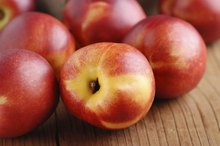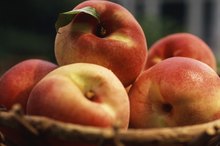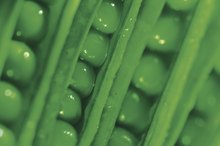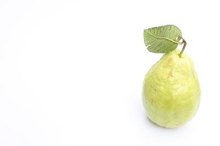Do Green Plantains Raise Your Blood Sugar?
What you eat directly affects your overall health and affects your blood sugar levels. Keeping your blood sugar levels controlled is one way to stay healthy, whether or not you are diabetic. One way to control your blood sugar levels is by eating food that does not raise your blood sugar levels quickly. Green plantains are an example of a food that will not cause your blood sugar to spike.
Blood Sugar Levels
The normal blood sugar range for adults with diabetes before meals is between 70 mg/dL to 130 mg/dL, the American Diabetes Association notes 1. The normal blood sugar range after meals is under 180 mg/dL. If your blood sugar levels fall below the normal range, then you are hypoglycemic, or have low blood sugar. If your blood sugar levels exceed the normal range, then you are hyperglycemic or have high blood sugar. The things you eat and drink generally cause your blood sugar to increase. That is why it is higher after meals compared to before you eat. However, the rate at which foods and beverages are converted into blood sugar varies depending on things such as sugar and carbohydrate content. Green plantain has between 21 grams to 34 grams of carbohydrates in every 120-gram serving, the American Journal of Clinical Nutrition says.
- The normal blood sugar range for adults with diabetes before meals is between 70 mg/dL to 130 mg/dL, the American Diabetes Association notes 1.
- The normal blood sugar range after meals is under 180 mg/dL.
- If your blood sugar levels fall below the normal range, then you are hypoglycemic, or have low blood sugar.
Glycemic Index
What Is Glycemic Index of Plantains?
Learn More
The glycemic index, or GI, is a means of classifying foods that have carbohydrates according to how quickly they elevate your blood sugar level. Essentially, foods with low GI elevate your blood sugar levels at a slower pace than foods with high GI. Foods that have high glycemic indices are quickly digested by your body, so the carbohydrates they contain are quickly absorbed into your body. In contrast, foods that have a low GI are not as quickly digested, so even if they contain the same amount of carbohydrates as high GI foods, their carbohydrate load will not be absorbed as quickly into your body. GI scores of 70 and above are considered high GI. Foods that have GI scores from 56 to 69 are considered medium GI. Any food with a GI of 55 or less is a low GI food.
- The glycemic index, or GI, is a means of classifying foods that have carbohydrates according to how quickly they elevate your blood sugar level.
- Essentially, foods with low GI elevate your blood sugar levels at a slower pace than foods with high GI.
Green Plantain Glycemic Index
The glycemic index of raw green plantain is 40, the American Journal of Clinical Nutrition notes. Boiled green plantain has a GI of 38. This means that green plantain is a low GI food, and will not raise your blood sugar rapidly after being eaten.
Other Nutrients in Green Plantain
What Happens to Sugar Levels in the Blood While Fasting?
Learn More
Green plantain also has phosphorus, calcium, vitamin C and folate.
Related Articles
References
- American Diabetes Association: Checking Your Blood Glucose
- USDA National Nutrient Database for Standard Reference; Plantains, Green, Fried (1); 2010
- Ebbeling, Cara, Leidig, Michael, Feldman, Henry, et al. Effects of a Low–Glycemic Load vs Low-Fat Diet in Obese Young Adults. Journal of the American Medical Association. 297.19 (2007):2092-2102.
- Fields, H., Ruddy, B., Wallace, M. R., Shah, A., & Millstine, D. (2016). Are Low-Carbohydrate Diets Safe and Effective? The Journal of the American Osteopathic Association, 116(12), 788. doi:10.7556/jaoa.2016.154
- Nielsen, J. V., & Joensson, E. A. (2008). Low-carbohydrate diet in type 2 diabetes: stable improvement of bodyweight and glycemic control during 44 months follow-up. Nutrition & Metabolism, 5(1). doi:10.1186/1743-7075-5-14
- Rush, Ilene Raymond. Is Low-Carb Eating Really Better for Blood Sugar? On Track Diabetes. July 12, 2018
- Selwin, Elizabeth, Coresh, Joseph, et al. Glycemic Control and Coronary Heart Disease Risk in Persons With and Without Diabetes. Archives of Internal Medicine. 2005. 165/16.
- Yancy, W. S., Foy, M., Chalecki, A. M., Vernon, M. C., & Westman, E. C. (2005). A low-carbohydrate, ketogenic diet to treat type 2 diabetes. Nutrition & Metabolism, 2, 34. doi:10.1186/1743-7075-2-34
Writer Bio
Joseph Pritchard graduated from Our Lady of Fatima Medical School with a medical degree. He has spent almost a decade studying humanity. Dr. Pritchard writes as a San Francisco biology expert for a prominent website and thoroughly enjoys sharing the knowledge he has accumulated.









